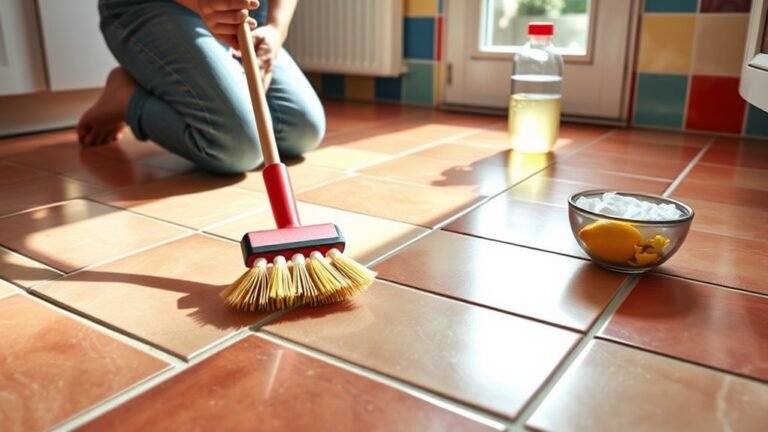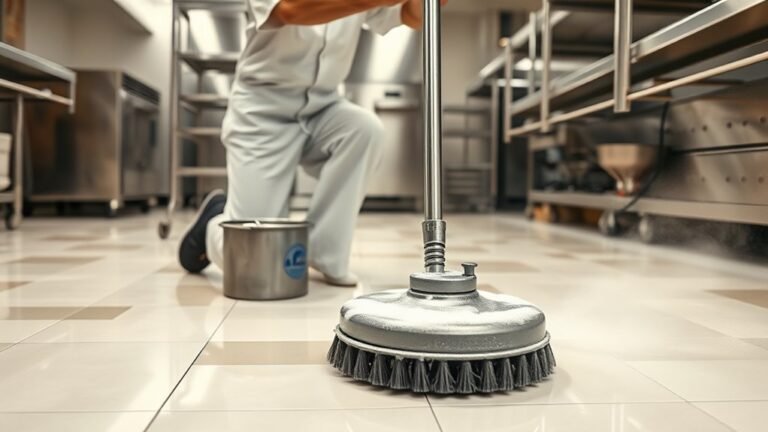How to Clean and Store Portable Air Conditioners
To clean and store your portable air conditioner, first unplug it and remove the filters to rinse with lukewarm water, letting them dry completely. Gently vacuum or wipe the coils and clean the water tray to prevent mold and odors. Wipe the exterior and make sure everything is dry before storing in a cool, dry place away from direct sunlight. Keeping your unit dry and well-maintained helps it last longer and work effectively next season. There’s more to know for ideal care.
Understanding Your Portable Air Conditioner Components
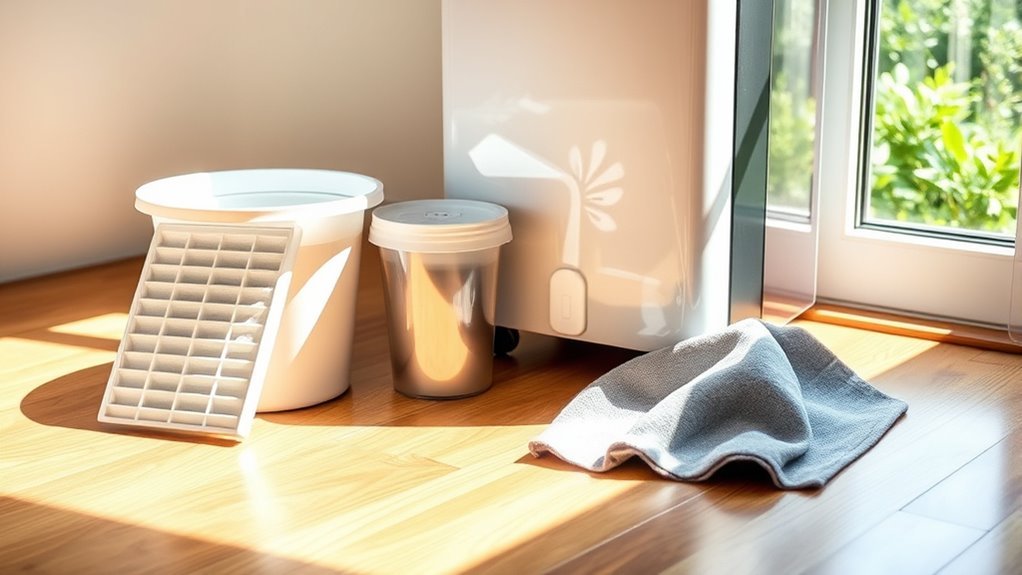
Before you start cleaning or storing your portable air conditioner, it’s important to understand its main components. Knowing these parts helps you maintain your unit better and boosts air conditioner efficiency. Portable AC types generally include single-hose and dual-hose models. Single-hose units pull air from your room, cool it, then expel warm air outside, making them simpler but sometimes less efficient. Dual-hose units use one hose to draw outside air for cooling and another to vent hot air, offering improved efficiency. Key components to recognize are the compressor, condenser, evaporator, and air filters—each playing a crucial role in cooling and airflow. By understanding these parts, you’re not just cleaning a machine; you’re preserving your freedom to enjoy cool, comfortable spaces without hassle.
Preparing Your Portable AC for Cleaning
Before you start cleaning, make certain to unplug your portable AC and let it cool down completely. Once it’s safe to handle, remove the filters carefully and check them for any dirt or damage. This prep work guarantees a smoother and more effective cleaning process.
Unplug and Cool Down
Start by unplugging your portable air conditioner to guarantee safety during cleaning. This simple safety precaution guarantees you won’t risk electric shock or damage to your unit while working on it. Once unplugged, give your AC time to cool down completely. This step is essential—not only does it protect you from burns, but it also prevents internal components from being stressed by sudden temperature changes. Allowing your unit to cool also supports energy efficiency when you restart it later, as the system won’t have to work extra hard to adjust. Taking these steps lets you clean your portable AC freely and safely, keeping it in top shape without hassle or risk.
Remove and Inspect Filters
One of the most important steps in preparing your portable AC for cleaning is removing and inspecting the filters. You want to take out the filter carefully, so you don’t damage it. Once removed, give it a thorough filter inspection to spot any dirt, dust buildup, or tears. A clean filter means your unit runs efficiently and the air stays fresh, giving you the freedom to breathe easy. If you notice your filter is worn out or too clogged to clean, don’t hesitate to opt for filter replacement. Keeping your filters in good shape not only extends your unit’s life but also saves you money in the long run. Regular filter inspection is your first line of defense against poor air quality and high energy use.
How to Clean the Air Filter
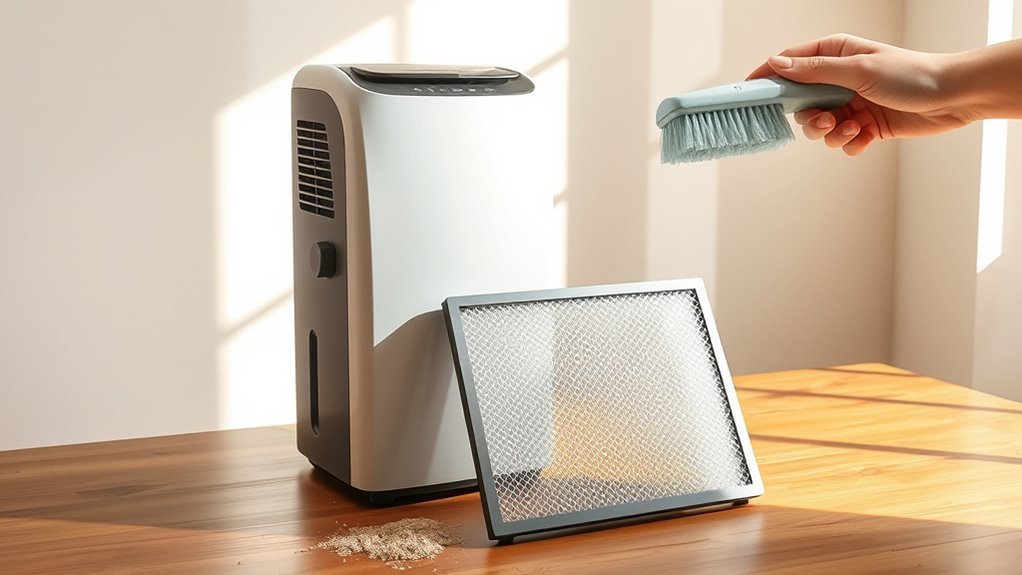
Although it might seem like a small task, cleaning the air filter is essential for keeping your portable air conditioner running efficiently. You want to maintain great air quality while enjoying your freedom from stuffy, stale air. To clean the filter, gently remove it and rinse it under lukewarm water. Avoid harsh chemicals—they can damage the filter. Let it air dry completely before reinstalling. Regular cleaning delays the need for filter replacement, saving you time and money. If the filter shows wear or damage, replace it promptly to guarantee your unit breathes easy. Keeping this simple routine will let your air conditioner perform at its best, giving you cool comfort without restrictions or worries about indoor air quality.
Cleaning the Condenser and Evaporator Coils
Since the condenser and evaporator coils work hard to transfer heat, keeping them clean is essential for your portable air conditioner’s efficiency. When dust or debris builds up, it not only reduces cooling power but can also cause condensation issues that lead to unwanted moisture or even mold. To maintain your freedom from costly repairs, tackle coil maintenance regularly. Gently vacuum the coils with a brush attachment or use a soft cloth dipped in a mild detergent solution. Avoid bending the delicate fins. Make sure the unit is unplugged before you start. Staying on top of coil care helps your air conditioner run smoothly and extends its lifespan, giving you reliable comfort without hassle. Keep these coils clean, and you’ll enjoy both efficiency and peace of mind.
Draining and Cleaning the Water Collection Tray
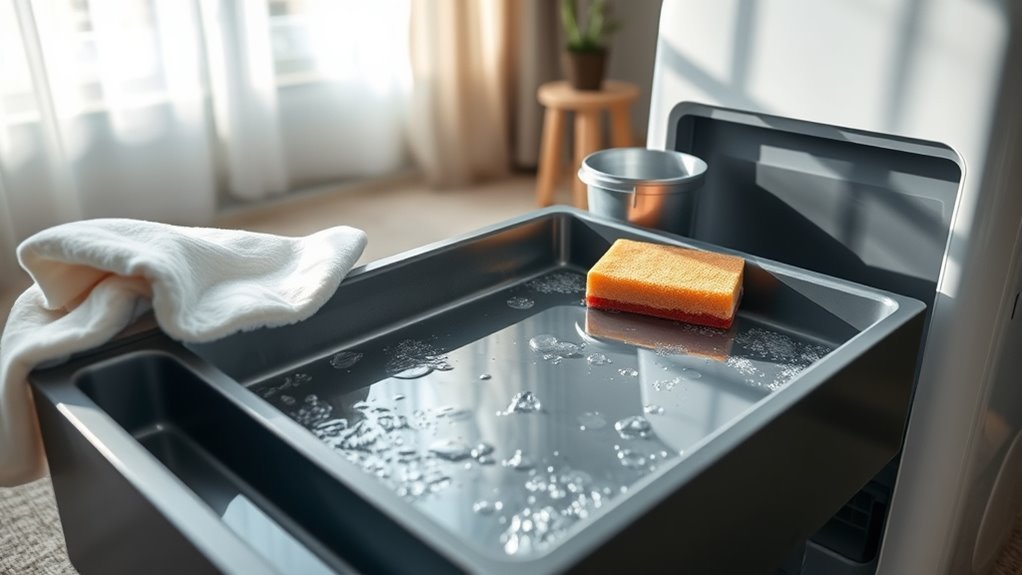
Every portable air conditioner has a water collection tray that catches condensation during operation, and keeping it drained and clean is vital to preventing mold and unpleasant odors. Start by locating the tray’s drainage plug or hose—this is your main point for water drainage. Carefully remove the plug or detach the hose to let all accumulated water flow out. After draining, wipe down the tray with a mild detergent solution to remove any residue or buildup. Regular tray maintenance like this not only prevents unpleasant smells but also keeps your unit running smoothly. Don’t forget to dry the tray completely before reassembling it to avoid moisture lingering. Staying on top of water drainage and tray maintenance gives you freedom from messy leaks and guarantees your portable AC stays fresh.
Wiping Down the Exterior Surfaces
When wiping down your portable air conditioner’s exterior, choose a soft cloth and mild cleaner to avoid damage. Use gentle, circular motions to remove dust and grime without scratching the surface. Aim to clean the exterior every few weeks to keep it looking fresh and functioning well.
Choosing Cleaning Materials
Although cleaning the exterior of your portable air conditioner might seem straightforward, choosing the right materials can make the process easier and protect your unit’s finish. To keep your AC looking fresh without causing damage, consider these essentials:
- Eco friendly cleaners – Opt for gentle, non-toxic solutions that won’t harm the environment or your health. They’re safe on surfaces and give you peace of mind.
- Microfiber cloths – These soft, lint-free cloths effectively lift dirt without scratching. Plus, they’re reusable, saving you money and waste.
- Soft-bristle brushes – For stubborn grime in crevices, a soft brush helps without damaging delicate parts.
Cleaning Technique Tips
Selecting the right cleaning materials sets you up for a smooth experience when wiping down your portable air conditioner’s exterior. Avoid common cleaning myths like using harsh chemicals or abrasive tools, which can damage the surface and shorten your unit’s lifespan. Instead, grab a soft cloth dampened with mild soap and water to gently remove dust and grime. Don’t rush—wiping in gentle, circular motions prevents scratches and keeps the finish looking fresh. One of the biggest maintenance mistakes people make is neglecting this simple step, leading to dirt buildup that can affect performance. By mastering these cleaning technique tips, you’ll protect your unit and enjoy the freedom of cool air without the hassle of frequent repairs.
Frequency of Wiping
Since dust and dirt can accumulate quickly, you should wipe down your portable air conditioner’s exterior at least once a week. Sticking to a consistent cleaning schedule not only keeps your unit looking fresh but also guarantees it runs efficiently. Here are some frequency recommendations to help you maintain freedom from heavy buildup:
- Weekly Wipe-Down: Use a damp cloth to remove dust and grime from the surface.
- Monthly Deep Clean: Combine wiping with checking vents and filters for any stuck debris.
- Seasonal Maintenance: Before storing or heavy use, perform a thorough cleaning to keep your unit in top shape.
Following this routine gives you control and peace of mind, letting your portable AC serve you better without hassle.
Properly Drying Your Portable Air Conditioner
Before storing your portable air conditioner, you’ll want to make sure it’s thoroughly dried to prevent mold and mildew buildup. Proper moisture control is essential—any lingering dampness can trap odors and damage the unit. Use effective drying techniques like wiping down surfaces with a dry cloth and leaving the unit open in a well-ventilated area.
Here’s a quick guide to help you master drying:
| Drying Technique | Purpose |
|---|---|
| Wipe with dry cloth | Removes surface moisture |
| Air dry in open space | Evaporates residual dampness |
| Use fans if needed | Speeds up moisture removal |
Selecting the Right Storage Location
Once your portable air conditioner is completely dry, the next step is to find a storage spot that protects it from damage and keeps it ready for the next season. Choosing the right location means thinking about ideal storage locations and climate considerations to guarantee your unit lasts longer.
Here are three tips to guide you:
- Indoor, Dry Space: Find a spot indoors, like a closet or garage, away from moisture and direct sunlight to prevent rust and fading.
- Stable Temperature: Avoid extreme heat or freezing temps that can damage internal components.
- Easy Access: Store it where you can easily reach it next season without hassle, keeping your freedom intact.
Picking the perfect place means your air conditioner will be ready whenever you need a cool breeze again.
Tips for Long-Term Storage Maintenance
Although your portable air conditioner is safely stored, you’ll want to perform regular maintenance checks to keep it in top shape. Every few months, inspect the unit for any signs of moisture buildup, which can lead to mold or damage. Use moisture control methods like placing silica gel packs or a dehumidifier nearby to keep the environment dry. Also, check for signs of pests—tiny critters love warm, enclosed spaces. Seal any gaps around your storage area and use natural pest prevention remedies, like cedar blocks or essential oils, to keep unwanted visitors out. By staying proactive with these simple steps, you’ll guarantee your portable air conditioner stays ready for action, giving you the freedom to cool your space whenever you want.
Frequently Asked Questions
Can Portable Air Conditioners Be Used in Humid Climates?
You can definitely use portable air conditioners in humid climates, but you’ll want to take into account their humidity control features. These units often help reduce moisture, making your space more comfortable even when the air feels heavy. Their climate adaptability means you’re not stuck with one solution; you can move them around or adjust settings to match your needs. So, you get freedom to stay cool and dry no matter where you are.
How Much Energy Does a Portable Air Conditioner Consume?
Imagine your portable air conditioner humming softly, like a breeze on a summer day, but how much energy is it sipping? Portable units vary, typically using between 500 to 1500 watts, depending on size and settings. You’ll want to look for energy efficiency ratings to keep costs low. Choosing an efficient model means you enjoy cool freedom without worrying about sky-high bills—maximizing cost savings while staying comfortably cool wherever you roam.
Are Portable Air Conditioners Suitable for Large Rooms?
When thinking about portable air conditioning, you’ll want to take into account your room size carefully. These units work best in small to medium spaces since their cooling capacity is limited compared to central systems. If your room’s large, you might find the cooling uneven or insufficient. But if freedom to move and easy setup matter most, portable units give you flexibility. Just match the unit’s BTU rating to your room size for the best comfort.
Can I Use My Portable AC as a Dehumidifier?
You can definitely use your portable AC’s dehumidifier function to help with humidity control in your space. While it’s not as powerful as a dedicated dehumidifier, it still pulls moisture from the air, making your environment more comfortable. This means you get freedom from sticky, damp air without extra devices. Just remember, it works best when the AC is running and the room is sealed well to trap the dehumidified air inside.
What Noise Levels Do Portable Air Conditioners Typically Produce?
Imagine a gentle hum like a distant conversation at a café—that’s the typical noise level of portable air conditioners. You’ll find their sound comparison often falls between 50 to 60 decibels, similar to a normal conversation or background music. Since you want freedom without distraction, these noise levels allow you to stay cool without feeling like you’re trapped in a noisy machine room. It’s like having cool comfort whispering in your space.



